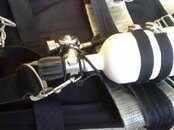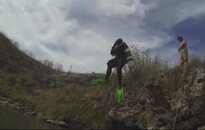CamG
Contributor
Yeah it can get ugly when you have to roll off or worse yet do the straight leg side entry.
I have had some really good entries / exits in smooth or rough waters and some train wrecks.
It really has been pretty versatile allowing me to gear up different ways for different boats.
One had a walk through transom and I geared kneeling on the tag line, stood up side stepped through the transom them put my fins on and stepped off.
I have in good conditions snapped tanks off on down line but in rough exits leave them on with fins clipped off on my rig.
This last season getting on and off a boat was a killer in my BM 108's as you had to step over the transom and it was rather high for a 30 in. inseam.
It made for a rather uncomfortable night with plenty of Advil!
This particular boat was difficult for SM divers as well but it seemed to be a tad bit easier than the big BM'ed doubles.
I have been spoiled by SM off my buddies boat and Florida Caves so it is always fun to mix it up a bit on a strange boat.
CamG
I have had some really good entries / exits in smooth or rough waters and some train wrecks.
It really has been pretty versatile allowing me to gear up different ways for different boats.
One had a walk through transom and I geared kneeling on the tag line, stood up side stepped through the transom them put my fins on and stepped off.
I have in good conditions snapped tanks off on down line but in rough exits leave them on with fins clipped off on my rig.
This last season getting on and off a boat was a killer in my BM 108's as you had to step over the transom and it was rather high for a 30 in. inseam.
It made for a rather uncomfortable night with plenty of Advil!
This particular boat was difficult for SM divers as well but it seemed to be a tad bit easier than the big BM'ed doubles.
I have been spoiled by SM off my buddies boat and Florida Caves so it is always fun to mix it up a bit on a strange boat.
CamG






